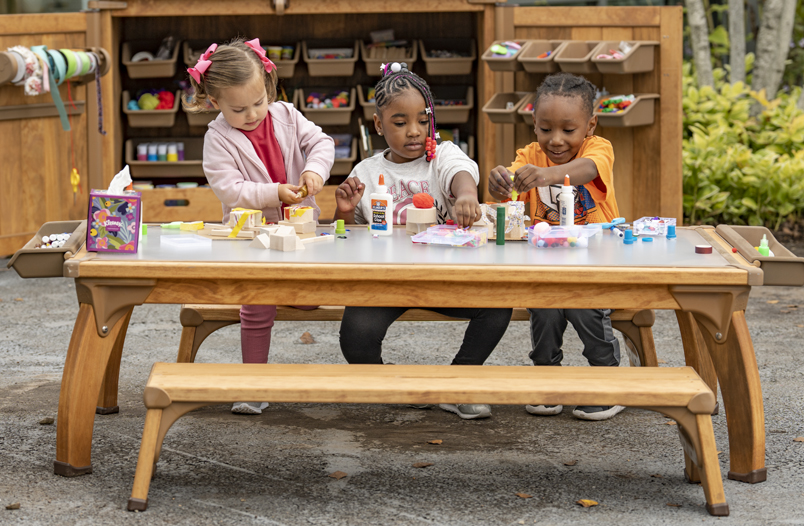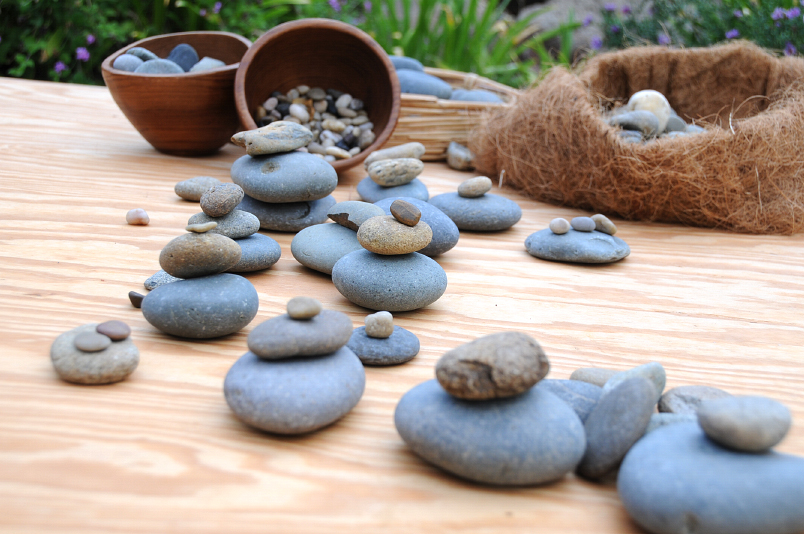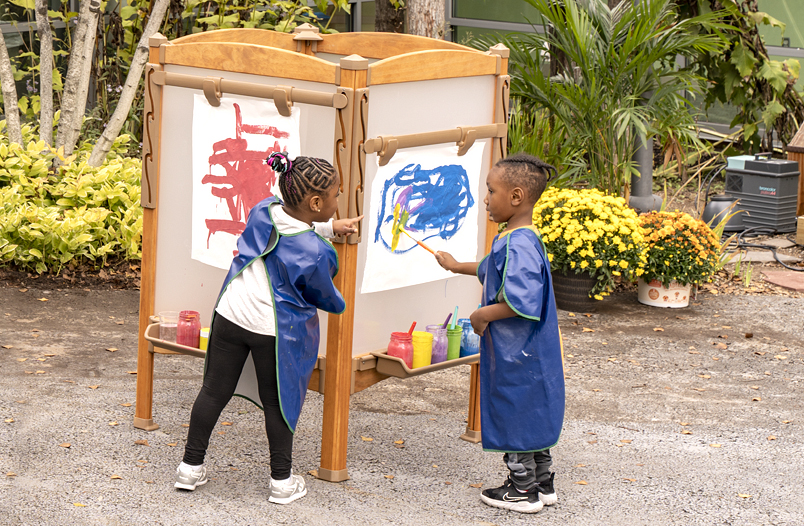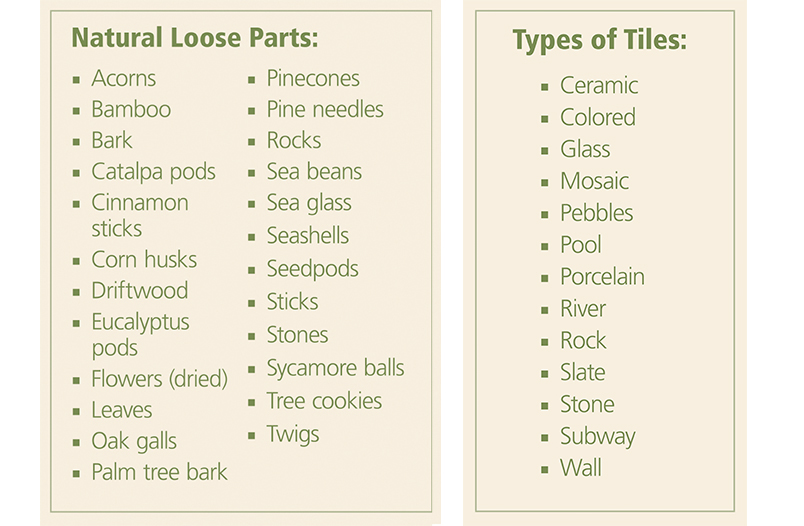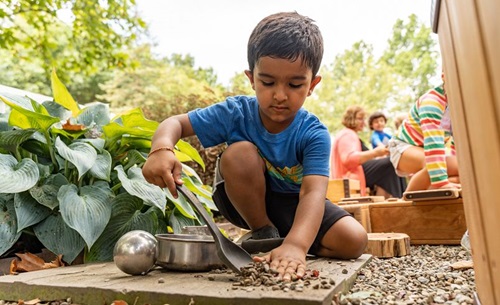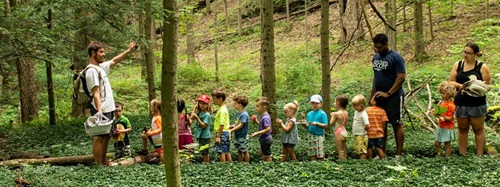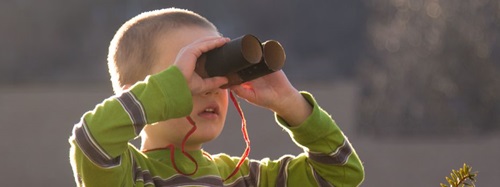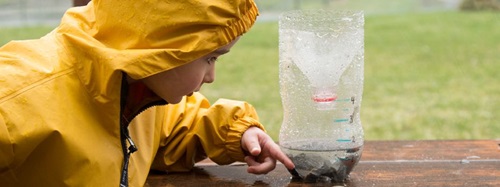The Best Art Studio of All: The Great Outdoors
The value of bringing art activities outside, and how to do it
| April 2024Traditionally, art has been viewed as an indoor classroom activity. But bringing art outdoors is not only doable—it is also an ideal environment for fostering children’s creativity.
Here’s all you need to know about why and how to make outdoor art possible for your children.
What Outdoor Art Does for Children
Bringing art activities outside has immense value for children. An outdoor art setting:
- Stretches the classroom by making alternate spaces for children to be creative. Having opportunities to do art outdoors creates a culture and environment that says imagination, originality, and resourcefulness are valued. When outside, children feel safe to explore and experiment. Unique spaces and materials coupled with time support creativity. Large expanses of concrete or asphalt offer a perfect surface for chalk drawings. The sandbox serves as the perfect sculpture studio, particularly when water, stones, leaves, and sticks are added. Unlimited designs may be created with flower petals, pebbles, and moss.
- Gives children varied art experiences and opportunities that support and challenge physical, emotional, social, cognitive, and creative growth. It encourages children to revisit what’s meaningful or of interest to them, supports in-depth art exploration, and deepens learning and understanding. For example, a child who is fascinated with stacking may spend days stacking tree cookies on boulders, tree rounds, or retaining walls as she learns how to balance materials to keep them upright. Later, she may discover that rocks or bark require different techniques to stack.
- Evokes our senses by being outside in nature. Artists often find inspiration in the natural world. Our visual, tactile, olfactory, and auditory senses are heightened while outdoors. Additionally, outdoor art explorations may provide varying opportunities for our proprioceptive sense—a person’s awareness of their own body in space—for example, while using large muscles to paint with a broom. Our baric sense, the ability to differentiate between different weights, may be enhanced outdoors by using stones of varying weights to create sculptures.
Advantages of the Outdoor Setting
There are many benefits to doing art outside. Here are a few:
- Messiness is anticipated and OK. Paint spills and splatters are not as much of a concern in outdoor environments. Children do not feel pressured to be neat, and educators are more relaxed. Paint or chalk on ground surfaces or fences may be hosed off or left for rain to wash away or sun to fade.
- Children have more freedom. Many outdoor experiences offer fewer constraints and more space than indoor environments. Work surfaces are often large, allowing children to go big with their movements and create large-scale pieces of art.
- Outdoor art experiences are more captivating for many children. Children who may not do art indoors will often participate in outdoor processes. Perhaps this is because many outdoor experiences involve larger movements, more action, and freedom, which children find appealing.
- Many outdoor art experiences are transient. Materials are often sustainable and reused. The opportunity to use materials freely is what counts in creative developmental art. For children, this involves open-ended discovery and exploration. The process is more important than a product, so there is no need to save and send home individual products.
- Natural materials offer opportunities for children to create art anywhere. Gathered leaves, seed pods, flowers, rocks, or sticks may be used for designs on a boulder, tree round, or in the sand. Natural sunlight heightens colors, and nature provides young artists with inspiration.
- The outdoors lends itself to large, collaborative art experiences. Creating huge box sculptures or rolling paint-covered balls in an extra-large cardboard box lid with classmates can be exciting and inspiring.
How Different Surfaces, Tools Open Creative Possibilities
Outdoor art can be done on tabletops, but consider other options that offer varied exploration. A change in location, surfaces beyond paper, and unique mark-making tools offer intriguing possibilities.
Locations
Vertical Planes: Portable or permanent outdoor easels offer children space to be creative and imaginative. Alternative vertical workspace may be made on fences or building walls. Children may paint directly on a wood fence or surfaces such as plywood or plexiglass that can be attached to chain-link fences or buildings. Different work surfaces such as cardboard can serve as the canvas. Spraying liquid watercolor on hanging bed sheets yields spectacular results. When finished, simply wash the sheets. Finger painting with shaving cream on upright plexiglass is a wonderful sensory experience.
Horizontal Planes: Take art to the ground by rolling out and securing long strips of roofing paper or placing canvas drop cloths directly on asphalt or concrete. Covering folding tables that lay flat on the ground with sturdy paper also creates a solid surface. Different motions are encouraged as children paint with a mop, go up and down with toilet plungers, or create large splats with sock drops on the large surfaces. Children delight in sweeping chalk across sidewalks, concrete, or unusual surface textures such as slate tile or roofing paper. Drawing with chalk on wet surfaces or with wet chalk results in brighter colors.
Diagonal Planes: Create a ramp by using a stiff, sturdy surface such as a sheet of plywood, cardboard, or rain gutters. Inclines may also be created with folding tables by extending legs on one end and collapsing legs on the other. Offer varied balls and wheeled vehicles for children to dip in paint and roll down ramps. Create a car/ball wash station for children to clean items when finished. This experience is more exciting than painting for some children.
Beyond Paper: Outdoor Work Surfaces
Alternatives to paper have the advantage of being durable and sustainable while providing large surface space for children to gain mastery of developing large muscles. Roofing paper and drop cloths, in particular, hold up to repetitive pounding motions and can handle multiple layers of paint.
Beyond Paint Brushes: Outdoor Paint Tools
Consider alternate mark-making tools beyond children’s paint brushes. Hardware stores and kitchen drawers are great places to find paint tools. Each utensil affords children varying experiences.
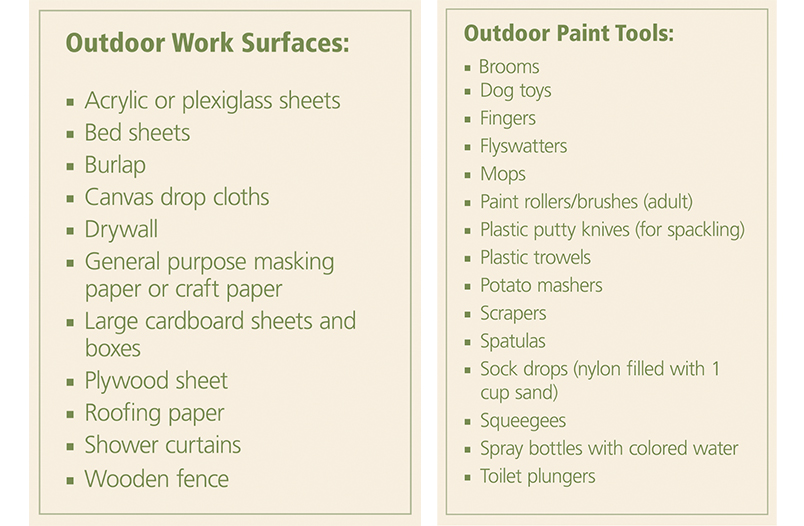
Ideas to Try
Consider Revisiting Art
Offer children a different tool each day to make multiple layers on the same paint surface. Vary paint colors to create contrast. For example, fingerpaint on day one; use scrapers on day two; and potato mashers on day three. Let the paint dry overnight. Interesting results unfold as multiple paint layers are added with different tools and paint colors.
Outdoor Painting on Canvas
Consider using canvas rather than paper as an authentic and sustainable painting surface that children will paint over repeatedly. Artists paint on canvas, and children love to use materials of real artists.
Throughout history it has been common practice for artists to paint over their work, particularly when canvas was scarce. Remember that children enjoy the process of painting rather than the final product.
Provide a canvas (16 by 20 inches) for each child with their name written on the back. Keep canvases accessible by storing them in a crate or leaning them against a wall or fence. When children want to paint, they get their canvas and place it on the easel. Set up a paint station so children may mix their own paint colors. Include small metal bowls, brushes, paint, a tub of water, and rags. Small pet bowls work well, as they are designed not to tip. Have pint-sized bottles of paint (16 ounces) for children to squeeze out desired amounts on their palette (bowl). Children can place their palette on a small worktable next to the easel and begin painting. When finished, children clean brushes and bowls in a washtub and set their canvas aside to dry. Children continue to paint on their canvas throughout the year. The paint will become thick, dry, and crackly as more layers are added, creating amazing textures. When the paint is very thick, the canvas can be sent home and a new one started.
Design and Representational Art
Creating space for children to do design and representational art encourages creativity and imagination. The work surface should be flat. A small table, tree round, bench, crate, or low coffee table work well. Create defined workspaces by providing placemats, picture frames, cutting boards, tree slabs, or large tiles upon which children can create designs. Provide an array of inviting and appealing materials stored in divided containers for children to make unique designs. Natural loose parts and tiles hold up well outside.
If children ask for glue, explain that sustainable artwork is temporary and lasts for a short time. It is all about placing materials in a thoughtful way. If a child asks to take an art creation home, talk about being able to reuse the beautiful materials, and take a photo of their work. In a sustainable art space, most explorations are done with loose parts, so water access isn’t usually needed for cleanup unless children are painting.
Sculptures
Outdoor spaces are perfect for large sculpture creations. A base is essential for adhering items. Materials that can be used as a base include cardboard and plywood. Constructions made with boxes of varying sizes, egg cartons, box lids, and cardboard tubes, rings, and computer packing materials are appealing. When glued materials have dried, children may paint their work. Structures may start with a base resting on a horizontal surface, but attaching the structure to a vertical surface for painting provides a different perspective.
Weaving
Weaving opportunities may be set up with large, simple looms made from a variety of items such as chain-link or orange safety fence, an old bed headboard, long sticks, or wooden dish drying rack. Add materials for weaving. These include textiles such as yarn, fabric strips, pipe cleaners, string, ribbon, and natural materials such as ferns, leaves, sticks, vines, bark, raffia, and flowers.
Why Storage at the Point of Play Is Important
Making materials accessible for the teacher and, when appropriate, for children, is essential to children's creativity. Children are more creative when they can independently make plans, try out ideas, and come up with solutions. Displaying materials in an inviting, orderly way allows children to use and return materials independently and gives the message that materials are available for their use.
Materials for an outdoor art studio are intended to stay outside to save the time and energy you’d use bringing materials in and out. Convenient storage and organization are necessary.
Organize items in shallow containers and on shelving units to keep the workspace ordered, clutter-free, and clean. This helps children find items easily and make selections independently.
Arrange loose parts by categories such as color, material, or shape. For instance, place all items together that are blue or metal, or make a collection of items that are all round. An accessible teachers’ shed may be helpful for securing materials and storing consumable materials such as paint. An outdoor shed, cabinet, armoire, art cart, or metal shelving unit are good options.
Having point-of-play storage offers teachers easy access to needed materials while maintaining supervision of children.
Conclusion
The outdoors is a unique studio, offering inspirational sensory experiences for young artists. By providing time, space, and resources, you can be sure that children’s creative expression will follow.
Further reading
Daly, Lisa and Miriam Beloglovsky. 2015. Loose Parts: Inspiring Play in Young Children. St. Paul, MN: Redleaf Press.
Daly, Lisa. 2022. Transforming Your Outdoor Early Learning Environment. St. Paul, MN: Redleaf Press.
Topal, Cathy Weisman and Lella Gandini. 2019. Beautiful Stuff from Nature: More Learning with Found Materials. Worcester, MA: Davis Publications, Inc.

